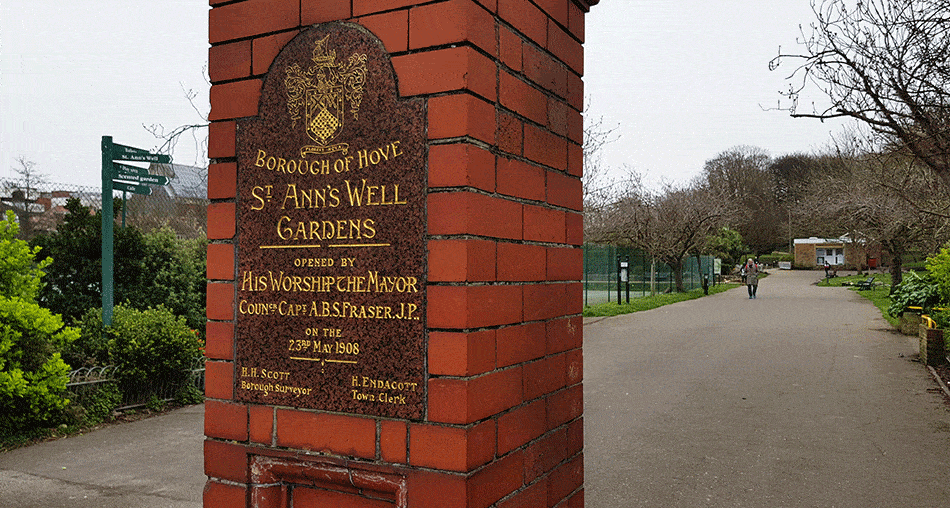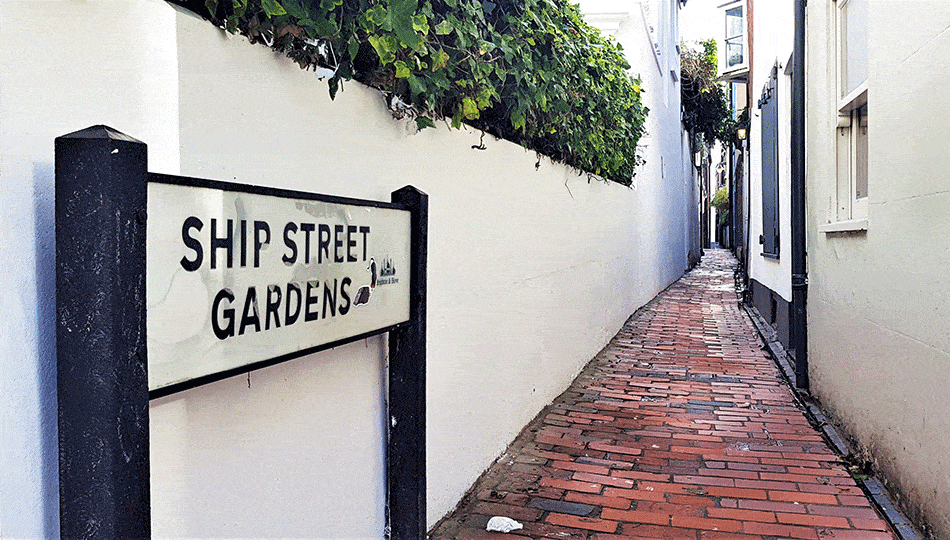If you want your experience in Brighton to be truly unique, then you’ll be looking to get off the beaten path and into some of the lesser-known locations in the city. Well, the good news is that there are plenty of them and we’ve found 12 of the best places to go for you.
10 Awesome Places Off The Beaten Track In Brighton
We’ve found 12 awesome places in Brighton off the beaten track, and they are the pet cemetery at Preston Manor, St. Ann’s Well Gardens, Stanmer House at Stanmer Park, The Chattri, St. Peter’s Church, The Victorian Bandstand, The Theatre Royal, The Ship Street Gardens, Kemptown Beach, Anna’s Museum, The Daddy Longlegs Railway and The Brighton Waste House!
The Pet Cemetery, Echoes Of Stephen King In Brighton?
OK, the good news is that whatever gets buried in Brighton’s Pet Cemetery stays buried, and the better news is that there are no vacancies, so it ought to remain that way.
If you want to visit, you’ll find it in the garden of Preston Manor (which is very much worth seeing in all of its Edwardian splendour). It is said to be the final earthly abode of the remains of approximately 20 dogs and a handful of cats.

What makes it unique is that along the stone wall, you’ll find little gravestones which were made for the occupants of this rather pleasant final resting space.
The Most recent animal buried here was a cat named George that used to belong to The Pavilion Palace. That’s right, names after the king himself. It’s a stunning place to visit, especially in the spring and summer. Do say hello to the head gardener who is more often than not at work in one part of the garden or another. His name is also George and must be said he is a really lovely guy.
1. St. Ann’s Well Gardens

If you know much about British folklore, then you’ll know about the importance of “ley lines” which are rumoured to be ancient sources of mystical power. St. Ann’s Well Garden is found on the leading end of a ley line and thus its rumoured magical properties might once have been real.
The well as St. Ann’s was formerly known as Chalybeate Spring, and it is said to have come into being when Annafrieda, a Saxon noblewoman, came across the body of her murdered lover and she burst into tears. It was her tears that gave birth to the well.
It is an exceptionally pretty place but sadly, the bowling green which once graced the gardens has now been closed and removed.
2. Stanmer House
If you love the idea of walking in the shoes of the British nobility, then you might want to visit the “Proud Country House” that is Stanmer House in Stanmer Park. It is only open at specific times which vary across the course of the year and it’s worth checking on their website before you plan a visit as to whether you can get in.
It’s a Grade 1 listed building surrounded by Grade 2 listed parkland, and it may be the best destination in the city for a truly sumptuous afternoon tea. Stanmer House is also available for weddings if you’re absolutely loaded and determined to spend it all at once.
3. The Chattri
The Chattri is one of Britain’s most unusual and remote war memorials. It is found on the South Downs overlooking Patcham in Brighton. It’s 150 meters above the city, and if you want to get to it, you can only access it by the bridleway nearby.
It commemorates the deaths of more than 800,000 Indian soldiers who fought for the British and their allies during World War 1. It was built in 1920 and 1921 and opened by Edward, Prince of Wales.
In the 1930s, sadly, it had already fallen into disrepair. Fortunately, in 1951 the War Office paid for its restoration, and the Royal British Legion took over its upkeep. The local Sikh community now attends to caring for The Chattri, which was made a Grade 2 listed building in 1974.
4. St. Nicholas’s Church
The Church of St Nicholas of Myra is best known simply as St. Nicholas Church. It is the oldest building in Brighton in its natural state. It is mentioned in the Domesday Book where it was valued at a somewhat miserly £12, though that was a huge sum of money back in 1086. However, the current building isn’t quite that old, it was built in the 14th century.
There are, however, some stones from the original building in use there, and the font was carved in the year 1170 from Caen Stone. The church was the only survivor of a French raid in 1514 when the nearby village was burned to the ground.
The stained-glass windows designed by Charles Eamer Kempe, one of Britain’s best stained-glass designers, are particularly worth your attention. Look up near the roof, which was moved to create more space and all the windows there are his too.
5. The Victorian Bandstand

If you want to be down by the sea, but you also want to escape the crowds, then you might want to venture down to the Victorian Bandstand, which is one of the finest examples of its kind. It’s delicately built and offers a spectacular view of the West Pier.
Many a Brighton couple has chosen to tie the knot at the bandstand thanks to the old-time vibe of the area. It’s highly recommended.
6. The Theatre Royal
It’s certainly not an unknown building in Brighton, but it is often overlooked by visitors who flock to its showier cousin, the Royal Pavilion. Yes, the theatre was also designed by George IV, and once you get inside, you can see the royal touches at every turn.
The layout implements four overlapping circles, each of which affords a majestic view of the drama on the stage. If you want to take in a play while you’re in Brighton, there is no finer venue than the Theatre Royal.
7. Ship Street Gardens

If you’re not from Brighton, you may never have come across the idea of “twittens” before. They are narrow passageways which run either between two walls or two hedges. The Lane is the oldest part of Brighton and has many twittens running through it, and each of them is worth visiting.
However, if you only have time to visit a single one of Brighton’s twittens then we’d recommend Middle Street Lane, which, as you might be able to guess, joins Ship Street with umm… Middle Street. It’s the perfect place to get away from it all, and we can recommend the record shop, Bella Union if you want some tunes to match your mood.
8. Kemptown Beach
Brighton Beach is brilliant. We’re not going to brook any argument on that score. Sure, you might prefer sand, but the atmosphere of the town’s main beach and Britain’s favourite holiday destination, is unbeatable. However, we will concede that sometimes, you just want a little peace and quiet to go with your sun and sea and when you do – that’s when you need Kemptown Beach.
The Kemptown side of Brighton Pier is the less busy part of Brighton Beach and more home to families and, dare I say, sober groups who want the sea and sun over the beach bars and Art Quarter bustle of between the piers.
This beach is a mile long and starts to the left of Brighton Pier (when looking out to sea) and runs for a mile east, right past Black Rock to the marina. When you get there, even on the hottest of days, you’ll find plenty of space, and we think, at least, far fewer seagulls which can become something of a nuisance on Brighton Beach when you want to eat a bag of chips or enjoy an ice cream.
9. Anna’s Museum

We’re sorry, but you can’t go into Anna’s Museum, and that’s because it’s not actually open to the public. However, if you’ve ever been curious about the state of taxidermy in the United Kingdom, then you might want to go and peer into the window anyway.
There is a regularly changing display in the window of some taxidermized exhibits that lay inside. Sadly, they are always in front of a firmly closed curtain which prevents us from guessing what lays further inside.
10. The Daddy Long Legs Railway
Many people think of Volk’s Electric Railway when they visit Brighton, but not many know that Volk had the second railway in Rottingdean. He implemented the Seashore Electric Railway in 1884, and it was the widest railway in the history of the world (and nothing has been built wider even to this very day).
Sadly, a week after it opened in 1896, it was wiped out in a freak electrical storm. It was repaired and reopened in 1897. However, the final nail in the railway’s coffin came in 1901 when the local authority removed large chunks of the railway to erect sea defences. However, you can still see the concrete pilings it was built on if you visit at an extremely low tide, and they look like “daddy longlegs”.
The Brighton Waste House, The Ghost Of Brighton’s Future?
Brighton University is home to this interesting exhibit. A home built entirely from trash. It is intended to demonstrate that you build a sustainable and legal home entirely from things that other people throw away.
We hope that projects like this will help tackle pollution and climate change which threaten Brighton’s long-term security.
Conclusion
There are plenty of awesome places to visit in Brighton, and many of them are off the beaten track. We’ve given you 12 great sights to begin with. How many more can you discover during your time in Brighton?


